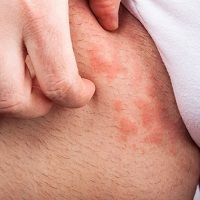Article
Predicting and Preventing Atopic Dermatitis in Children
Author(s):
Atopic dermatitis, sometimes referred to as baby eczema, affects more than three million infants in the United States every year. While there are no established preventive measures, researchers have been making strides in coming up with effective treatment strategies.

Atopic dermatitis, sometimes referred to as baby eczema, affects more than three million infants in the United States every year. While there are no established preventive measures, researchers have been making strides in coming up with effective treatment strategies.
It can start with a rash that suddenly appears and continues to cause dry, itchy skin. Whether atopic eczema pops up on the face, legs, or diaper area, children are often the sufferers of the condition. Marc A. Riedl, MD, MS, from the University of California, San Diego, brought focus to the skin condition at the 2015 American College of Allergy, Asthma, and Immunology Annual Scientific Meeting (ACAAI 2015) in San Antonio, Texas.
Filaggrin (FLG) is a filament-associated protein and deficiency has been linked to the atopic dermatitis. Transepidermal water loss (TEWL), a widely validated open chamber, non-invasive system, seems to predict skin barrier dysfunction when it comes to the condition. An analysis conducted in Ireland included 1,903 infants and a logistical regression found factors that could predict atopic dermatitis at 12 months. The children were assessed by questionnaire and exam after two, six, and 12 months. By the end of the year, 15.5% of the infants were diagnosed with atopic dermatitis.
When the researchers looked at FLG, 1,164 of the infants had the wild-type and 136 had an FLG mutation. Although the earliest TEWL signal can be present at day two, the stronger signal comes by two months. However, the FLG mutation isn’t significant at two months.
“So there is a strong correlation between water loss and the FLG mutation,” Riedl pinpointed. Therefore, it would be fair to say that improving the skin barrier function could help FLG mutations which lead to atopic dermatitis.
If there were a way to prevent to atopic dermatitis in infants, would families take the necessary steps? Prevention trials for atopic dermatitis have largely been disappointing, Riedl said. The researchers wanted to see the effect of emollient (moisturizer) enhancement from birth and tried to choose subjects that were pre-genetically exposed to eczema — 45% of the mothers and 21.7% of the fathers had the condition. Out of the 124 infants, 64 had daily emollient application (families could choose oil, cream, or ointment) and the other 60 had usual infant skin care. The regimens began three weeks after birth and lasted for six months. Adherence to the application came in at 81.5% by the end of the study, which reassured that the process was feasible.
By the end of six months, 21.8% in the emollient group and 43.4% in the placebo group developed atopic dermatitis. Three patients in each group experienced mild superficial cutaneous infections, suggesting that emollient doesn’t present a safety issue. There is already a larger study with long-term follow-up underway to further investigate the practice, but it appears that emollient application may have preventative properties against atopic dermatitis.
Eczema is a common, but its cause remains unknown. It’s believed that genetic and environmental factors contribute to the onset but more research is needed to identify the missing pieces in prevention and treatment.





